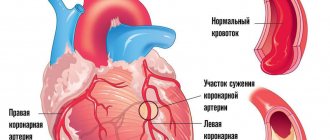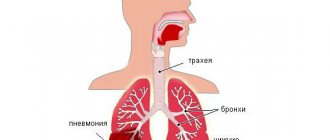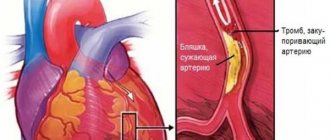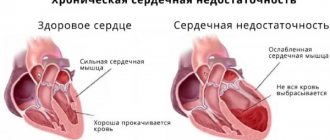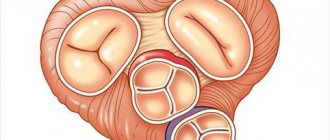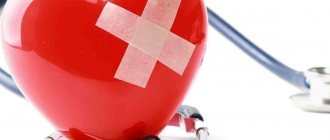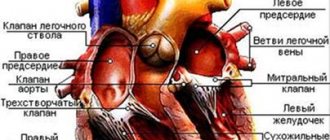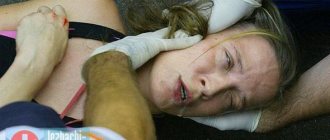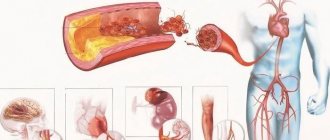Chest pain is not always a sign of cardiac pathology, but only a neurological symptom. It is important to know how to distinguish heart pain from osteochondrosis in order to take timely measures. We'll talk about this in more detail later.
Chest pain does not always indicate cardiac pathologies
Impact of osteochondrosis on the heart
Medicine knows several reasons why osteochondrosis causes pain behind the sternum, in the area of the heart, while the functionality of the heart is not affected, only the superficial nerves are affected.
Osteochondrosis can cause pain behind the sternum
The mechanism of pain formation is as follows:
- With osteochondrosis, there is a possibility of pinching of the nerve roots that innervate the chest organs. As a result, intercostal neuralgia develops, characterized by symptoms very similar to those of the heart. Only a thorough examination will help to find out whether these are coronary disorders or not.
- One of the main symptoms of osteochondrosis in the upper spine is a disturbance in the movement of impulses. Signals to sensitive receptors stop receiving. Malfunctions occur in the functioning of the autonomic nervous system, which is involved in the innervation of the heart, and reflex cardialgia develops. The patient feels pain behind the sternum when moving the upper limbs.
- Enlarged vertebrae and spasm of the back muscles with osteochondrosis almost always cause circulatory problems, increased blood pressure, and the risk of developing myocardial infarction.
The main characteristics of pain arising from cardiac pathologies
Heart disease is divided into several types of pathology: angina pectoris, myocardial infarction, pericarditis, myocarditis.
Each pathology is accompanied by specific signs, having an idea of which, a person can sound the alarm in time and seek help from a medical institution.
Angina pectoris
An attack of angina is an acute heart failure caused by vasospasm, resulting in insufficient oxygen reaching the heart. The heart begins to contract harder, causing unpleasant sensations such as:
- sudden pain like a prick;
- pain radiates to the upper limbs;
- appear: panic, anxiety, fear of death;
- lack of air, suffocation;
- increased sweating;
- pallor of the skin.
With angina pectoris, pain appears, similar to an injection.
The pain disappears in a short time, as unexpectedly as it appeared. Heart rhythm returns to normal.
The nature of the pain helps differentiate angina from thoracic osteochondrosis. Pain when nerve endings are pinched always occurs or disappears with body movement and does not go away after using heart medications (nitroglycerin). The pain that occurs with this cardiac pathology is provoked by stress, intense physical activity, sudden temperature changes, overeating and goes away after taking nitroglycerin.
The intensity of pain during angina pectoris does not increase with coughing or movement, but may reappear during exercise.
Myocardial infarction
Myocardial infarction occurs as a result of a blood clot formed in an artery, which clogs the lumen of the vessel. Blood circulation in this place stops, the integrity of the vessel is disrupted, which leads to bleeding and death of nearby tissues. All this is accompanied by the following symptoms:
- sharp, sudden pain that occurs in most cases at night;
- inability to move due to pressing pain behind the sternum;
- panic attacks, resulting in an increase in the level of adrenaline in the blood. Due to the release of adrenaline, the coronary vessels dilate, the pressure drops, and the person loses consciousness;
- severe weakness, feeling of cold, vomiting, thready pulse.
During myocardial infarction, sharp, sudden pain appears.
Life-threatening pain is the main symptom that distinguishes a heart attack from osteochondrosis.
Heart attack pain generally does not arise out of nowhere, but is the result of atherosclerosis, coronary heart disease.
Pericarditis
Pericarditis occurs when the serous membrane of the heart becomes inflamed. Inflammation disrupts the contractile function of the heart, causing unpleasant symptoms:
- pain of increasing nature;
- hyperthermia;
- respiratory dysfunction;
- nausea and vomiting;
- When listening to the heart, a murmur is heard.
Inflammation of the lining of the heart during pericarditis
The main difference between cardiac pain during pericarditis and chondrosis is increasing pain, the intensity of which increases for several days.
Myocarditis
Myocarditis is an inflammation of the heart muscle, accompanied by the following symptoms:
- slow heartbeat;
- low blood pressure;
- sensations of pain behind the sternum, pressing in nature;
- breathing problems, shortness of breath;
- pale skin with a bluish tint;
- swelling.
Inflammation of the heart muscle with cardiac myocarditis
Symptoms of pain of a pressing nature are a distinctive feature from pain with osteochondrosis.
Causes and risk factors of angina
The root cause of “angina pectoris” is atherosclerosis. Atherosclerotic plaques develop in the coronary arteries, the source of which is cholesterol. The vessels become clogged, and the lumen inside them narrows or is completely blocked. Therefore, nutrients do not enter the organ. During Heberden's disease, the organ deprived of nutrition is the heart. Due to lack of oxygen, it begins to hurt.
The appearance of angina pectoris can be triggered by the following reasons:
- IBS.
- Thromboembolism of the coronary arteries.
- Deviation in the development of heart vessels. These are both congenital and acquired anomalies.
- Spasms of blood vessels supplying the heart muscle.
Heredity can also be one of the reasons for the appearance of “angina pectoris”.
Spinal diseases can provoke so-called “non-cardiac” pain in the heart
Factors contributing to the occurrence of attacks of Heberden's disease are:
- tachycardia;
- stressful situations;
- exercise stress;
- exiting a warm room into the cold.
Regardless of the gender of patients, angina pectoris can occur at different ages. Female representatives are protected from atherosclerosis by their reproductive function, but this is provided that it works correctly. With the onset of menopause, the production of the sex hormone estrogen decreases, which becomes the cause of heart disease. The stronger sex is more susceptible to pathology, regardless of age-related changes in the body.
Pain in the sternum with damage to the vertebrae
There is a nerve connection between the spine and the heart, which is located in the lower edge of the cervical spine. Consequently, when osteochondrosis affects the cervical and thoracic regions, pain may occur that resembles pain in cardiac pathology.
With osteochondrosis of the cervical and thoracic spine, pain similar to heart pain may appear
Diagnostics
Diagnostics presents significant difficulties in terms of differential diagnosis with cardiovascular diseases (angina pectoris, coronary artery disease). Diagnostic measures begin with an examination of the patient by the therapist and assessment of his objective data. To clarify the diagnosis, the patient is sent for additional examination:
- blood, urine for general analysis;
- blood chemistry;
- ECG;
- EchoCG;
- according to ECG readings according to Holter (24-hour monitoring of cardiac activity);
- X-ray of the cervicothoracic spine in 2 projections;
- MRI as indicated.
The exclusion of cardiovascular pathology is confirmed by the absence of changes in the ECG, which can be performed under load and over time to assess heart function. After the examination, the patient is sent for a consultation with a neurologist and cardiologist, followed by a diagnosis and treatment.
So what is the difference between heart pain and osteochondrosis?
Let's compare the symptoms of the two pathologies in the table.
| Comparison category | Cardialgia | Osteochondrosis |
| Pain and its nature | Pressing, paroxysmal. With pericarditis, the pain increases. | Shooting, aching pain. |
| Localization | In the chest area with the possibility of irradiation to the upper extremities. | Encircling, along the intercostal nerves, radiating to the collarbone, scapula, back. |
| Duration | It occurs quickly and unexpectedly. Lasts 20-30 minutes. | From instant shooting to constant aching pain. |
| Factors that provoke pain | Stress, heavy load on the heart. | Sudden movements, coughing, palpation of the ribs, uncomfortable position. |
| Effect of drugs | Nitroglycerin relieves heart and angina attacks. | The pain is eliminated after taking painkillers and NSAIDs. |
Instrumental studies
To differentiate pathologies in diagnosis, instrumental research methods such as ECG, ultrasound, radiography, CT and MRI are used.
ECG
An electrocardiogram will help to distinguish heart pain from pain due to osteochondrosis, thanks to which the biopotentials of the heart are recorded.
Using an ECG, you can distinguish pain due to osteochondrosis from heart pain.
Ultrasound
An ultrasound examination of the heart allows us to identify all pathologies of this organ, if any. Allows you to examine the functionality of the aorta and arteries, measure the speed and movement of blood flow through them.
Ultrasound of the heart will help identify heart pathologies
Radiography
To recognize pathology in the heart (especially when its contours change) or to identify osteochondrosis, an X-ray image of the spine is possible, which shows all the degenerative changes in the vertebrae. And with a detailed study of the image of the thoracic spinal column, you can see the chambers of the heart and the aortic arch.
X-ray of the heart will help detect heart pathology or osteochondrosis
CT and MRI
The most reliable differentiated methods for studying cardiac pain from osteochondrosis are CT (computed tomography) and MRI (magnetic resonance imaging). They allow you to scan all internal organs, identifying pathology.
Cardiac CT and MRI are the most reliable research methods
Treatment
Intense pain due to neuralgia will not allow you to ignore this pathology. It is necessary to urgently seek help from a specialist who will establish a diagnosis and recommend means of combating intercostal neuralgia to avoid the development of more serious complications.
Treatment of intercostal neuralgia is as follows:
- Relief of pain using painkillers (“Gevadal”, “Baralgin”, “Spazmalgon”, “Analgin”, “Brustan”, “Trigan-D”) and NSAIDs (“Celebrex”, “Melox”, “Ketanov”, “ Ketorolac", "Ibuklin", "Dicloberl", "Movalis").
- In case of low effectiveness of NSAIDs and other painkillers, hormonal drugs are needed - Ambene, Diprospan.
- Elimination of pinched nerves and inflammation using novocaine blockades.
- Elimination of the cause that led to the development of neuralgia.
- Reduced physical activity, use of corsets.
- Manual therapy.
- Reflexology.
- Physiotherapy.
- Exercise therapy.
- Massage.
Knowing the differences between pain due to osteochondrosis and heart pathology will allow you to contact the right specialist in time.
How to relieve discomfort?
Drug treatment of osteochondrosis is indicated during the period of its exacerbation; therapy for the early stages of the disease consists of prescribing therapeutic exercises, physiotherapeutic procedures, and massage.
Prescription of medications
The use of medications is aimed at pain relief, eliminating inflammation and improving blood circulation in tissues, restoring mobility to joints:
- anti-inflammatory and painkillers (Voltaren, Nurofen, Ketonal, Nimesil, Movalis) in the form of gels, creams for external use, capsules, tablets for oral administration or injections;
- vasodilators and restoring blood circulation (Trental, Actovegin);
- muscle relaxants (Sirdalud, Mydocalm) - have a calming and relaxing effect on the muscles;
- chondroprotectors (Chondroxid, Alflutop) – promote the restoration of cartilage tissue.
Osteochondrosis is often accompanied by a person’s depressive-stressful state, so the doctor may prescribe sedatives (Cymbalta, Donormil).
Self-administration of medications can aggravate the course of the disease, therefore, if signs of osteochondrosis appear, consultation with a specialist is necessary.
Additional procedures to relieve spasms
The following methods will help alleviate the patient’s condition and speed up the recovery process::
- massage – eliminates pain, improves blood circulation and has a restorative effect;
- physical therapy – performing a special set of exercises helps restore joint mobility;
- physiotherapeutic procedures (electrophoresis, darsonvalization) - accelerate recovery and are a catalyst for the effects of medications;
- reflexology (acupuncture, acupuncture, applicators) – impact on biologically active zones on the body normalizes metabolic processes in tissues.
On our website you will find useful publications telling about the causes, signs and methods of treating osteochondrosis of the thoracic spine in men and women. Also, in separate articles, our experts talk about possible symptoms of the disease such as fever, dry cough and difficulty breathing.
